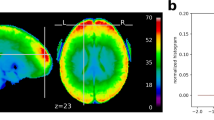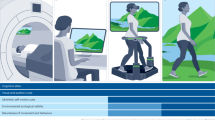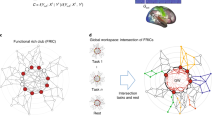Abstract
Functional brain imaging can be used to map the neural systems that underlie human behaviour. To probe the intrinsic complexity of the human mind and brain, a large repertoire of highly sophisticated behavioural challenges are used in imaging research. In patterns as varied and complex as the behaviours by which they are elicited, activations are reported in any and all brain areas. Describing this experimental corpus by context and content is the logical prelude to any attempt to interpret, compare or combine data across studies or centres.
This is a preview of subscription content, access via your institution
Access options
Subscribe to this journal
Receive 12 print issues and online access
$189.00 per year
only $15.75 per issue
Buy this article
- Purchase on Springer Link
- Instant access to full article PDF
Prices may be subject to local taxes which are calculated during checkout

Similar content being viewed by others
References
Fox, P. T. & Lancaster, J. L. Neuroscience on the Net. Science 266, 994–996 (1994).
Fox, P. T., Parsons, L. M. & Lancaster, J. L. Beyond the single study: function/location metanalysis in cognitive neuroimaging. Curr. Opin. Neurobiol. 8, 178–187 (1998).
Fox, P. Spatial normalization: origins, objectives, applications and alternatives. Hum. Brain Mapp. 3, 161–164 (1995).
Fox, P. T., Mintun, M. A., Reiman, E. M. & Raichle, M. E. Enhanced detection of focal brain responses using intersubject averaging and change-distribution analysis of subtracted PET images. J. Cereb. Blood Flow Metab. 8, 642–653 (1988).
Watson, J. D. G. et al. Area V5 of the human brain: evidence from a combined study using positron emission tomography and magnetic resonance imaging. Cereb. Cortex 3, 79–94 (1993).
Zilles, K. et al. Quantitative analysis of sulci in the human cerebral cortex: development, regional heterogeneity, gender difference, asymmetry, intersubject variability and cortical architecture. Hum. Brain Mapp. 5, 218–221 (1997).
Hasnain, M. K., Fox, P. T. & Woldorff, M. G. Structure–function covariance in the human visual cortex. Cereb. Cortex 11, 702–716 (2001).
Lancaster, J. L. et al. Automated labeling of the human brain: a preliminary report on the development and evaluation of a forward-transform method. Hum. Brain Mapp. 5, 238–242 (1997).
Lancaster, J. L. et al. Automated Talairach atlas labels for functional brain mapping. Hum. Brain Mapp. 10, 120–131 (2000).
Fox, P. T. et al. Location-probability profiles for the mouth region of human primary motor–sensory cortex: model and validation. Neuroimage 13, 196–209 (2001).
Xiong, J. et al. Intersubject variability in cortical activations during a complex language task. Neuroimage 12, 326–339 (2000).
Paus, T. Location and function of the frontal eye fields: a selective review. Neuropsychologia 34, 475–483 (1996).
Picard, N. & Strick, P. L. Motor areas of the medial wall: a review of their location and functional activation. Cereb. Cortex 6, 342–353 (1996).
Schulman, G. L. et al. Common blood flow changes across visual tasks. I. Increases in subcortical structures and cerebellum but not in visual areas. J. Cogn. Neurosci. 9, 623–646 (1997).
Acknowledgements
The development of BrainMap was supported by the National Library of Medicine and the National Institute of Mental Health, the Human Brain Project and the EJLB Foundation. We thank S. Petersen, J. Xiong and L. Parsons for much helpful advice in BrainMap design and logistics. We thank A. Hecker, P. Kochunov and S. Mikiten for development of software for BrainMap and the Talairach Daemon. We thank S. Fox and M. Crank for extensive testing of the BrainMap coding scheme for designing and developing BrainMap training tools and procedures.
Author information
Authors and Affiliations
Corresponding author
Related links
Related links
FURTHER INFORMATION
Encyclopedia of Life Sciences
brain imaging: localization of brain functions
brain imaging: observing ongoing neural activity
MIT Encyclopedia of Cognitive Sciences
Rights and permissions
About this article
Cite this article
Fox, P., Lancaster, J. Mapping context and content: the BrainMap model. Nat Rev Neurosci 3, 319–321 (2002). https://doi.org/10.1038/nrn789
Issue Date:
DOI: https://doi.org/10.1038/nrn789
This article is cited by
-
Contributions of the left and right thalami to language: A meta-analytic approach
Brain Structure and Function (2024)
-
Improving the Eligibility of Task-Based fMRI Studies for Meta-Analysis: A Review and Reporting Recommendations
Neuroinformatics (2023)
-
The Impact of Gamification on Doctoral Students’ Perceptions, Emotions, and Learning in an Online Environment
TechTrends (2023)
-
Co-alteration Network Architecture of Major Depressive Disorder: A Multi-modal Neuroimaging Assessment of Large-scale Disease Effects
Neuroinformatics (2023)
-
Accurate localization and coactivation profiles of the frontal eye field and inferior frontal junction: an ALE and MACM fMRI meta-analysis
Brain Structure and Function (2023)



